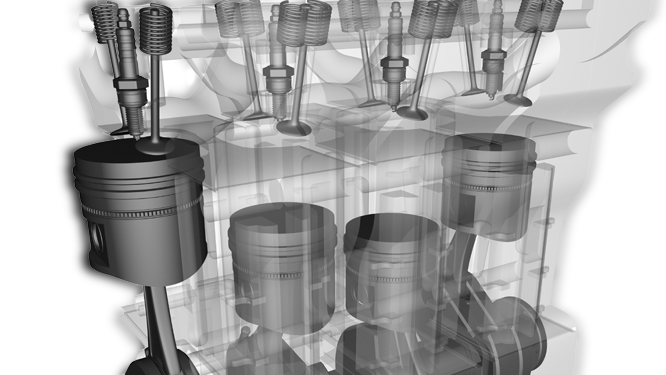Nowadays you’ll most likely find a four-stroke engine works in your car. This means the type of car engine works has four essential steps for internal combustion. It consists of igniting a mixture of fuel and air to create a small explosion in the cylinders.
The engine works of the car are built around the cylinders which are sealed metal tubes with a spark plug and two valves on one side and a crankshaft on the other inside of the cylinder are pistons. Pistons are tight-fitting pumps like plungers. These are to the crankshaft and slide up and retract from the explosion. The inlet valve and outlet valve and the air or gas in and release exhaust respectively. When the spark plug ignites the gas, the piston moves and turns the crankshaft. The turning movement from the crankshaft transfers to the gearbox and moves the vehicle forward.
Movement of Pistons:
The movement of pistons is created in four steps. Intake compression and exhaust first the piston is pulled down in the cylinder while the inlet valve injects a fuel and air mixture into the cylinder second the valve closes and the piston moves back up. This compresses the mixture to be ready for ignition after compression. The spark plug ignites the mini-explosion and creates a hot gas that forces the piston back, turning turns the crankshaft. Finally, the force on the crankshaft powers the continuous turning. Forcing the piston back up the outlet valve then opens releasing the exhaust from the cylinder. The repetition of this process in each cylinder in rapid succession creates an enormous force that drives your vehicle forward.
Types of Engines
Inline or straight line engines:
In a straight engine, the cylinders are arranged in a line parallel to the car from front to back. This arrangement allows for more cylinders and straight engine works commonly found in powerful cars such as BMW and Mercedes.
An inline layout is when the cylinders are arranged side by side in an upright position across the engine bay perpendicular to the car. Inline engines are the most common form of engine and are found on most hatchbacks and small family cars.
V-engines:
V engine works refer to the shape at which the cylinders when viewed from the front. The cylinders in a V engine are mounted on their site at a 60-degree angle with two rows facing outwards connected by a crankshaft at the base of the V shape. They can to fit a large number of cylinders and can be found on premium or high performance.
Flat or boxer engines:
A flat engine layout is when the cylinders are mounted horizontally with two rows facing outwards though not very common. Flat engine works are highly regarded for offering a low center of gravity within the engine bay which aids handling one of the largest manufacturers of flat engines is Porsche which uses a flat 6 engine in their legendary sports car.
Opposed piston engines:
The opposed piston engine works as pairs of pistons are coaxial but rather than sharing a crankshaft, it shares single combustion per pair of pistons. The crankshaft configuration varies amongst the post dungeon designs. One layout has a flat or boxer engine at its center and adds an opposed piston to each end. So there are two pistons per cylinder on each side. Petrol and diesel are opposed piston engines that have been used mostly in large scale-applications such as ships, military tanks, and factories.
W engines:
W engine works have cylinders in a configuration in which the cylinder banks resemble the letter W in the same way as those of a V engine. W12 engines with three banks of four cylinders were used by several aircraft engines from 1917 to the 1930s. A three-bank design was also used for an unsuccessful w12 engine which was intended to compete in formula one in 1990.
X engines:
An engine works are essentially two V engines joined by a common crankshaft a majority of these were existing v12 engines converted into an x24 configuration. Only two examples of x engines are known to have reached production. The first was the 1939-1942 Rolls-Royce vulture. A 42-1 x-24 aircraft engine was built using two Rolls-Royce peregrine v12.
U engines:
U engines consist of two separate straight engines joined by gears or chains. Most U engine works have four cylinders such as square four engines and tandem twin engines. U engines were produced from 1915 to 1987 for use in airplanes racing cars motorcycles locomotives and tanks.
H engines:
H engines consist of two separate flat engines joined by gears or chains. H engine works have been produced with between four and 24 cylinders. The H engine is relatively rarely out with its main use being in aircraft engines. During the 1930s to 1940s the 1966 lotus 43 formula one car used 16 cylinders. H engine and an eight-cylinder H engine were used for powerboat racing in the 1970s.
Radial engines:
A radial engine works as a single crankshaft with cylinders arranged in a planer star shape around the same point on the crankshaft. This configuration was commonly used with five air-cooled cylinders in aircraft.
Deltic engines:
A delta engine works has three or multiple cylinders having opposing pistons aligned in three separate planes or banks so that they appear to be in a delta when viewed along the axis of the main shaft. A notable example of this type of layout is the Napier Deltic. The Deltic engines were used in two types of British locomotives. The top 1962 built class 55 and 1959 built class 23. These locomotive types were known as deltix and baby deltix.

